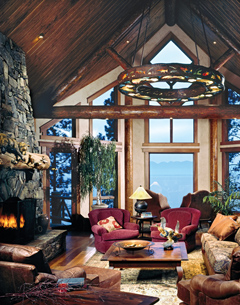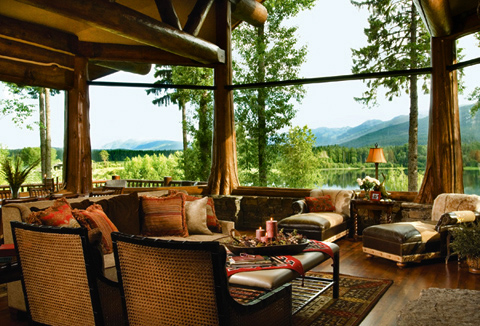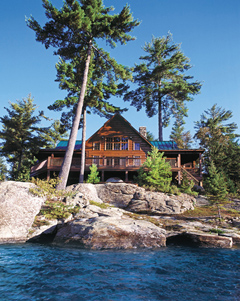What’s the first thing you think of when someone mentions the phrase “waterfront property”? Does it conjure up images of a quiet, glassy lake tucked high in the mountains? Maybe it makes you think of a busy, babbling river, providing a constant, soothing soundtrack to daily life. Or perhaps the pounding surf and aroma of salty air that only an oceanfront parcel of land can bring?
 Landmark Builders/photo by Heidi A. Long
Landmark Builders/photo by Heidi A. LongWaterfront living means something different to everyone, just like everyone’s idea of a log home is different. But fortunately, living in a log home by the water is a natural fit that can bring you a lifetime of happiness—if you design it to fit your location as much as to your lifestyle. It’s not hard, it just takes some thought, and we’re here to help you ride the log home wave to success.
Oceans and lakes are highly popular places to build, but remember: there is a limited amount of shoreline, so lots are likely to be smaller, making homes closer to each other. Be conscious of how you position your outside living spaces, like decks and patios. If privacy is important to you, be strategic.
Don’t forget that, architecturally, your home has two “front” sides—one from the street and one from the water —and you want it to show well from both. Many people forget this fact and underdesign one side or the other. Log home builder Dan Mitchell, owner of Tennessee-based Eagle CDI, explains that the façades don’t have to be elaborate, but be sure to put some thought into them. “When you have a spectacular view like a water vista, be sure you set the expectation of what’s to come from the onset with a gorgeous front door and a pleasing façade. If you don’t, the psychological impact could make even the most beautiful lake or dramatic sea to seem lackluster.”
Most lakes are an inlet/outlet, meaning their water level stays pretty constant. In fact, many larger lakes are dammed and the water level is managed. For those that are not, there typically is a natural overflow that acts as a stabilizing force. One thing to be conscious of is the prevailing wind pattern. In some areas, lake winds can be intense, and if your home has large overhangs on the windward side, they can catch the wind beneath them in much the same way that airplane wings do and start to pull your roofing materials away from the house, which can result in moderate to severe roof damage. With proper design, this is easily avoidable, and can save you thousands of unnecessary dollars in roof repair.
 Natural Log Creations/photo by Heidi A. Long
Natural Log Creations/photo by Heidi A. LongRivers are beautiful, lively, and full of fun. It’s tempting to place your home close to the edge so you can hear that wonderful sound from just about every room in the house. But rivers are also unpredictable. A huge snowstorm hundreds of miles away can melt, causing swelling downstream. If your home is sited too close to the bank, it’s in grave danger of flooding—not just once but repeatedly throughout the years. Protect yourself and your investment with a little research. Visit your local town hall or historical society and find out what the most severe high-water mark has been in the past 100 years and how many times it’s actually reached that mark (or came close to it). Then walk your property looking for soggy spots or signs of chronic water infiltration during different times of the year. Essentially, get to know the land and let it help you decide where the best place to build would be—both for your benefit and the land’s, not to mention for insurance purposes.
 Montana Timber Structures/photo by Roger Wade
Montana Timber Structures/photo by Roger WadeModern stains and sealants make it possible to build a log home with any species of wood in just about any environment. Pine is just as at home along the sea as cedar. Different species will take on different characteristics when exposed to certain kinds of conditions, however, and though all of them are structurally sound, you may want to consider this when deciding what kind of look you want your home to have. For instance, in the pine/cedar example, there’s a reason why cedar is so popular along the coast; the salt spray encourages that silvery sheen. Other species such as pine can take on a rich, darker patina. Cypress, on the other hand, grows naturally in coastal areas and will remain virtually unchanged other than the shade of stain you choose (if you choose to alter the color at all). All of them are beautiful, just know what look you want and be sure to buy a species that will give it to you easily without a lot of upkeep.
According to Dan Mitchell, the extra moisture produced from every kind of waterfront property can cause logs to degrade faster than than they would at other building sites, which is why it’s imperative that they are treated properly from the beginning. “The logs should arrive to the site pretreated with a preservative. Plus, during the stacking process, they should be treated again before they are erected into the home and the stain is applied. This simple step in the early stages will add to the longevity of the stain and the logs and reduce the homeowner’s maintenance efforts,” he says. “Think of it as a loaf of bread,” he explains. “Once you open the bag and expose it to air, you increase the chances for mold and bacteria to attach to the bread. If you leave the bag open for a few days, those chances increase exponentially. Then, if you close the bag and essentially seal in those spores, you create a condition where the mold can thrive. The same principle can apply to your logs. Prevent the chances for contamination early and you won’t have to reseal, repair, or replace them later.”
 Natural Log Creations/photo by Heidi A. Long
Natural Log Creations/photo by Heidi A. LongReflectivity of water adds to daily UV exposure and thus shortens the life of stains, according to Paul Peebles with Perma-Chink Systems in Redmond, Washington. “Larger roof overhangs, porches, and shading from trees all help minimize that. When it comes to choosing a stain, waterborne stains with clear maintenance coats work best,” he says. Furthermore, Peebles advises that elements of the home that are the most exposed to weather, such as porch handrails, deck handrails, and the portions of the home above the roofline (e.g., dormers) should be constructed of the most durable materials possible.
Erosion and sedimentation are natural processes, caused by the churning of the waves continually lapping at the dry land, often undercutting it and pulling it back into the body of water. But when you build along the shore, you are technically “interfering” with nature. The most notable problem is that you will eventually lose part of your waterfront parcel, either gradually or sometimes dramatically, in the case of a hurricane or other force of nature. The severity of the issue depends on your location and the intensity of the waves, but there are things you can do to shore up your property. Each area has different needs so do a little surfing online to see how you can protect your aqua-environment.
When it comes to some areas of your log home, sometimes faux is the way to go. For instance, for soffits and facia, Dan Mitchell uses “concrete board” that mimics the look of wood and can be stained and sealed. The reason is that in a highly moist environment the thinner wood boards absorb the moisture faster than thick, solid walls, making them decay faster and require replacement sooner. Concrete board can last for decades, merely requiring periodic stain touchups.
No matter what kind of water body your home is built on, chances are you enjoy time on the water (otherwise, why would you choose waterfront property, right?). So when you’re designing your home, make sure you build in space to store your gear. Boats, wave runners, canoes, fishing poles, surf boards (some toys are bigger than others and may require their own garage, shed, boathouse, etc.), all will need to be stored so they are easily accessible.


